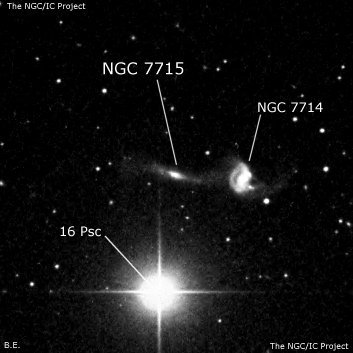
George Johnstone Stoney, Lord Rosse's assistant, discovered NGC 7715 on 4 Nov 1850. While maing an observation of NGC 7714 he noticed "a faint neb follows NGC 7714] about 2'." Dreyer measured an accurate position in 1876 using the offset from 16 Psc.
400/500mm - 17.5" (8/7/91): very faint, very small, elongated 2:1 WSW-ENE. Located 3.2' N of mag 5.7 16 Psc, which detracts from viewing. Forms a close pair (Arp 284) with much brighter NGC 7714 1.8' W.
600/800mm - 24" (8/30/16): at 322x; fairly faint, moderately large, very elongated 4:1 WSW-ENE. Contains a brighter core and low surface brightness extensions (arms) that increase in size with averted vision to ~1.4'x0.35'. On images the western arm or tidal bridge stretches to brighter NGC 7714 1.8' W, though there was no visual connection. Located 3' N of mag 5.7 16 Psc!
900/1200mm - 48" (10/26/16): at 610x; fairly bright, moderately large, thin edge-on 6:1 WSW-ENE. Dominated by a small, bright elongated core ~20"x8" that increases to a star-like nucleus. Long stretched tidal arms or plumes extend WSW-ENE, ~1.8'x0.3'. The western "arm" heads towards the center of NGC 7714 [1.9' W], but dims out before reaching the halo. Mag 5.7 16 Psc is just 3.3' S and the glare affected viewing unless moved off the field.
[HB89] 2333+019, a faint distant quasar, lies 2.6' NE of the center of NGC 7715. At a redshift of z = 1.871, the light-travel time is 10.2 billion years. It was generally visible with averted vision despite a V magnitude of 18.3. The quasar wasn't our target - Jimi noticed it on his monitor when we were observing NGC 7714/15, so of course Howard, Jimi and I had to take a look and we were pleased it was readily visible.
Notes by Steve Gottlieb